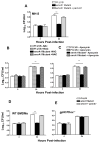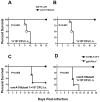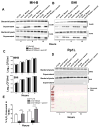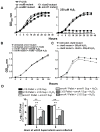EmrA1 membrane fusion protein of Francisella tularensis LVS is required for resistance to oxidative stress, intramacrophage survival and virulence in mice
- PMID: 24397487
- PMCID: PMC4097035
- DOI: 10.1111/mmi.12509
EmrA1 membrane fusion protein of Francisella tularensis LVS is required for resistance to oxidative stress, intramacrophage survival and virulence in mice
Abstract
Francisella tularensis is a category A biodefence agent that causes a fatal human disease known as tularaemia. The pathogenicity of F. tularensis depends on its ability to persist inside host immune cells primarily by resisting an attack from host-generated reactive oxygen and nitrogen species (ROS/RNS). Based on the ability of F. tularensis to resist high ROS/RNS levels, we have hypothesized that additional unknown factors act in conjunction with known antioxidant defences to render ROS resistance. By screening a transposon insertion library of F. tularensis LVS in the presence of hydrogen peroxide, we have identified an oxidant-sensitive mutant in putative EmrA1 (FTL_0687) secretion protein. The results demonstrate that the emrA1 mutant is highly sensitive to oxidants and several antimicrobial agents, and exhibits diminished intramacrophage growth that can be restored to wild-type F. tularensis LVS levels by either transcomplementation, inhibition of ROS generation or infection in NADPH oxidase deficient (gp91Phox(-/-)) macrophages. The emrA1 mutant is attenuated for virulence, which is restored by infection in gp91Phox(-/-) mice. Further, EmrA1 contributes to oxidative stress resistance by affecting secretion of Francisella antioxidant enzymes SodB and KatG. This study exposes unique links between transporter activity and the antioxidant defence mechanisms of F. tularensis.
© 2014 John Wiley & Sons Ltd.
Conflict of interest statement
The authors have no conflict of interest to declare.
Figures








Similar articles
-
Characterization of a Unique Outer Membrane Protein Required for Oxidative Stress Resistance and Virulence of Francisella tularensis.J Bacteriol. 2018 Mar 26;200(8):e00693-17. doi: 10.1128/JB.00693-17. Print 2018 Apr 15. J Bacteriol. 2018. PMID: 29378894 Free PMC article.
-
TolC and EmrA1 contribute to Francisella novicida multidrug resistance and modulation of host cell death.J Bacteriol. 2024 Sep 19;206(9):e0024624. doi: 10.1128/jb.00246-24. Epub 2024 Aug 28. J Bacteriol. 2024. PMID: 39194223 Free PMC article.
-
Identification of Francisella tularensis live vaccine strain CuZn superoxide dismutase as critical for resistance to extracellularly generated reactive oxygen species.J Bacteriol. 2009 Oct;191(20):6447-56. doi: 10.1128/JB.00534-09. Epub 2009 Aug 14. J Bacteriol. 2009. PMID: 19684141 Free PMC article.
-
Molecular and genetic basis of pathogenesis in Francisella tularensis.Ann N Y Acad Sci. 2007 Jun;1105:138-59. doi: 10.1196/annals.1409.010. Epub 2007 Mar 29. Ann N Y Acad Sci. 2007. PMID: 17395737 Review.
-
Will the enigma of Francisella tularensis virulence soon be solved?Trends Microbiol. 2003 Mar;11(3):118-23. doi: 10.1016/s0966-842x(03)00020-9. Trends Microbiol. 2003. PMID: 12648943 Review.
Cited by
-
Components of the type six secretion system are substrates of Francisella tularensis Schu S4 DsbA-like FipB protein.Virulence. 2016 Nov 16;7(8):882-894. doi: 10.1080/21505594.2016.1168550. Epub 2016 Mar 30. Virulence. 2016. PMID: 27028889 Free PMC article.
-
Comparative Transcriptional Analyses of Francisella tularensis and Francisella novicida.PLoS One. 2016 Aug 18;11(8):e0158631. doi: 10.1371/journal.pone.0158631. eCollection 2016. PLoS One. 2016. PMID: 27537327 Free PMC article.
-
Elucidation of a mechanism of oxidative stress regulation in Francisella tularensis live vaccine strain.Mol Microbiol. 2016 Sep;101(5):856-78. doi: 10.1111/mmi.13426. Epub 2016 Jun 16. Mol Microbiol. 2016. PMID: 27205902 Free PMC article.
-
Preclinical testing of a vaccine candidate against tularemia.PLoS One. 2015 Apr 21;10(4):e0124326. doi: 10.1371/journal.pone.0124326. eCollection 2015. PLoS One. 2015. PMID: 25897786 Free PMC article.
-
Stress responses in an Arctic microalga (Pelagophyceae) following sudden salinity change revealed by gene expression analysis.Commun Biol. 2024 Sep 4;7(1):1084. doi: 10.1038/s42003-024-06765-7. Commun Biol. 2024. PMID: 39232195 Free PMC article.
References
-
- Federal Register. Biennial review, Final rule. 194. Vol. 77. Federal Register; 2012. Possession, use and transfer of select agents and toxins; pp. 10–5. - PubMed
-
- Allen LA. Mechanisms of pathogenesis: evasion of killing by polymorphonuclear leukocytes. Microbes Infect. 2003;5:1329–1335. - PubMed
-
- Allen LA, McCaffrey RL. To activate or not to activate: distinct strategies used by Helicobacter pylori and Francisella tularensis to modulate the NADPH oxidase and survive in human neutrophils. Immunol Rev. 2007;219:103–117. - PubMed
-
- Atkins HS, Dassa E, Walker NJ, Griffin KF, Harland DN, Taylor RR, et al. The identification and evaluation of ATP binding cassette systems in the intracellular bacterium Francisella tularensis. Res Microbiol. 2006;157:593–604. - PubMed
Publication types
MeSH terms
Substances
Grants and funding
LinkOut - more resources
Full Text Sources
Other Literature Sources
Miscellaneous

